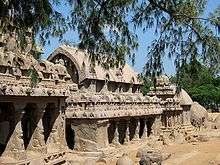Mahendravarman I
Mahendravarman I (600–630 CE)[2][3] was a Pallava king who ruled the Southern portion of present day Andhra region and Northern regions of what forms present-day Tamil Nadu in India in the early 7th century. He was a scholar, painter, architect, musician. He was the son of Simhavishnu, who defeated the Kalabhras and re-established the Pallava kingdom.
| Mahendravarman I | |
|---|---|
 The rock-cut temples at Mahabalipuram. Construction of these started in the reign of Mahendravarma I[1] | |
| Pallava king | |
| Reign | 600–630 CE |
| Predecessor | Simhavishnu |
| Successor | Narasimhavarman I |
| Issue | Narasimhavarman I |
| House | Pallava |
| Father | Simhavishnu |
| Pallava Kings (200s–800s) | |
| Virakurcha | |
| Vishnugopa II | |
| Simhavarman III | |
| Simhavishnu | |
| Mahendravarman I | (600-630) |
| Narasimhavarman I | (630–668) |
| Mahendravarman II | (668–670) |
| Paramesvaravarman I | (670–695) |
| Narasimhavarman II | (700-728) |
| Paramesvaravarman II | (728–731) |
| Nandivarman II | (731–795) |
| Dantivarman | (795–846) |
| Nandivarman III | (846-869) |
| Nrpatungavarman | (869-880) |
| Aparajitavarman | (880-897) |
During his reign, the Chalukya king Pulakeshin II attacked the Pallava kingdom. The Pallavas fought a series of wars in the northern Vengi region, before Mahendravarma decimated his chief enemies at Pullalur (according to Pallava grants at Kuram, kasakudi and tadantottam). Although Mahendravarma saved his capital, he lost the northern provinces to Pulakeshin.[4] Tamil literature flourished under his rule, with the rise in popularity of Tevaram written by Appar and Sambandhar. Mahendravarman I was the author of the play Mattavilasa Prahasana which is a sanskrit satire and another play called Bhagavadajjuka.
Mahendravarma was succeeded to the throne by his more famous son Narasimhavarman I in 630 CE.[2] who defeated Pulakeshin II of Chalukya dynasty and ransacked the Chalukyan capital city of Vatapi (also known as Badami).
Patronage of arts and architecture
Mahendrravarma was a great patron of letters and architecture. He constructed a Lighthouse in Mahabalipuram and also constructed Kanchi University where vedas, Buddhism, Jainism, Painting, Music & Dance was taught. He was the pioneer of Rock-cut Architecture amongst the Pallavas.[5] The inscription at the rock-cut Mandagapattu Tirumurti Temple hails him as Vichitrachitta and claims that the temple was built without wood, brick, mortar or metal. The five-celled cave temple at Pallavaram was also built during his reign as was the Kokarneswarar Temple, Thirukokarnam of Pudukottai, Tamil Nadu.[6]He made Kudimiya malai Inscription. His paintings are found in Sittanavasal Cave (Tamil Nadu).
Fine examples of his rock-cut temples can be witnessed at Mahabalipuram, (Satyagirinathar and Satyagirishwarar twin temples), Siyamangalam (the Siva temple Avanibhajana Pallaveswaram) in North Arcot district and the upper rock-cut temple at Trichy. Apart from the Siva temples, Mahendravarma also excavated a few Vishnu cave temples, the Mahendravishnugrha at Mahendravadi, and the Ranganatha Temple at Singavaram in present-day Gingee (then North Arcot district).[7]
He was also the author of the play Mattavilasa Prahasana, a farce concerning Buddhist and Saiva ascetics. He is also claimed to be the author of another play called Bhagavadajjuka,. This is evident by the inscriptions found at Mamandur cave shrines (near Kanchipuram - this place is mentioned as Dusi Mamandur to avoid confusions with other places by the same name). However, there is an alternate view that attributes this play to Bodhayana.[8]
Religion
Mahendrravarma was initially a patron of the Jainism,[9] but he converted into the Saiva faith under the influence of the Saiva saint Appar. According to Dhivyacharitam a Sanskrit work on life of Alwars written in 12th century, Yatotkara perumal (mahavishnu), enshrined in Kancheepuram left the city along with his great devotee Thirumalisai Alvar, because the Vaishnava Alwar faced tough persecution and exilement from the king who had at least temporarily come under the influence of Jainism.[10][11]
Notes
- Sen, Sailendra (2013). A Textbook of Medieval Indian History. Primus Books. p. 41. ISBN 978-9-38060-734-4.
- Hall, John Whitney, ed. (2005) [1988]. "India". History of the World: Earliest Times to the Present Day. John Grayson Kirk. 455 Somerset Avenue, North Dighton, MA 02764, USA: World Publications Group. p. 246. ISBN 1-57215-421-7.CS1 maint: location (link)
- Seventeen, Volume. Indian kingdoms by royal asiatic society of great britain. Royal asiatic society of great Britain.
- KAN Sastri, A History of South India, p136
- Gopal, Madan (1990). K.S. Gautam (ed.). India through the ages. Publication Division, Ministry of Information and Broadcasting, Government of India. p. 217.
- KAN Sastri, A History of South India, p412
- KAN Sastri, A History of South India, p413
- KAN Sastri, A History of South India, p313
- Somasundaram, O; Tejus Murthy, AG; Raghavan, DV (2016), "Jainism - Its relevance to psychiatric practice; with special reference to the practice of Sallekhana", Indian J Psychiatry, 58 (4): 471–474, doi:10.4103/0019-5545.196702, PMC 5270277, PMID 28197009
- KAN Sastri, A History of South India, p 382–383
- Stein, p 122
References
- Prasad, Durga (1988). History of the Andhras up to 1565 A. D. Guntur, India: P. G. Publishers.
- Sastri, K A N (2008). A History of South India (4th ed.). New Delhi, India: Oxford University Press.
- Stein, Burton (1998). A history of India. Cambridge, MA: Blackwell Publishers. ISBN 0-631-20546-2.
Mahendravarman I | ||
| Preceded by Simhavishnu |
Pallava dynasty 600–630 |
Succeeded by Narasimhavarman I |